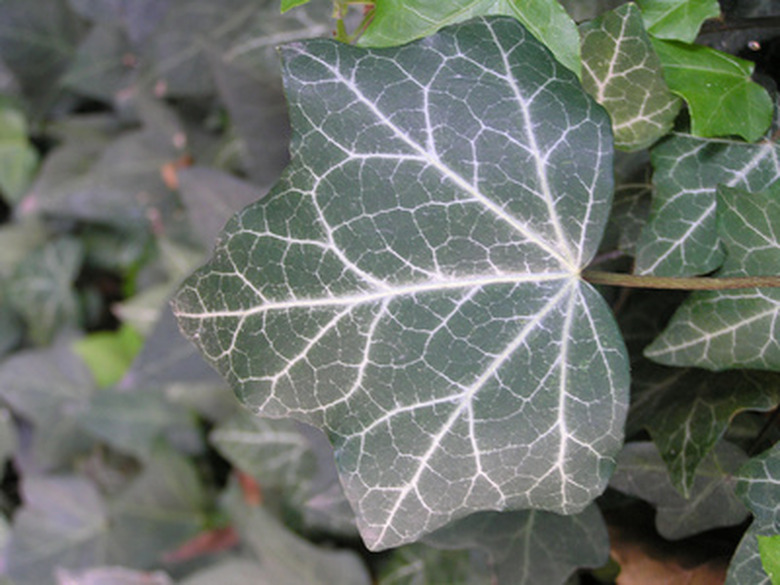English Ivy & Cats
How entrancing an English ivy plant can be to a cat–leaves fluttering in the breeze, stems trailing like tails of some mysterious animal–and dangerously toxic. Devoted cat owners recognize English ivy as ranking high on common lists of plants toxic to both cats and dogs, along with human infants and toddlers. The active toxin in English ivy, the glycoside hederin, attacks both digestive and nervous systems and is capable of causing coma. The plant's official name, Hedera helix L., suggests the strong presence of this toxic chemical. What cat owners may not know is that there are other reasons to avoid using English ivy, either as a houseplant or in more extensive outdoor landscaping. Plant experts are becoming increasingly convinced that English ivy, at least in the U.S., is not good for cats, people or other plants.
Dangers of English Ivy to Cats
According to the Plant Conservation Alliance's "Least Wanted" List, ingesting English ivy can produce diarrhea, intestinal upset, hyperactivity, coma, breathing difficulties, muscular weakness and lack of coordination. Toxic symptoms appear to be similar for people and animals (PCA notes that English ivy's irritating-to-severe qualities actually speed propagation of seeds by birds.) A possibly poisoned cat needs medical attention for ivy poisoning as quickly as possible.
- How entrancing an English ivy plant can be to a cat–leaves fluttering in the breeze, stems trailing like tails of some mysterious animal–and dangerously toxic.
- Plant experts are becoming increasingly convinced that English ivy, at least in the U.S., is not good for cats, people or other plants.
Other Dangers Presented by English Ivy
Once sought out as a quick landscape tool (English ivy grows rapidly and remains evergreen in winter in moderate climates), English ivy is increasingly listed as a Noxious and Invasive weed on USDA plant websites. A non-native member of the ginseng family, English ivy clambers wall and bark surfaces so enthusiastically that it has been slated for active eradication in Washington and Oregon and labeled as a plant of concern in 16 other states.
Damage Done by English Ivy
Even an indoor cat will feel the impact of the destruction English ivy can wreak on a landscape. The weakening and death of large shade trees suffocated English ivy can change the moisture and temperature of a yard and the house situated on it. Persistent attacks by ivy roots weaken the mortar around residential bricks, permitting water leaks and mold formations, eradicated only by expensive repointing. Energetic English ivy damages wooden and stucco exteriors as well in its climb. Plants supporting healthy air circulation and welcoming wildlife diversity can be destroyed by this invasive plant. The results can be deleterious to you and your cat.
- Once sought out as a quick landscape tool (English ivy grows rapidly and remains evergreen in winter in moderate climates), English ivy is increasingly listed as a Noxious and Invasive weed on USDA plant websites.
- Persistent attacks by ivy roots weaken the mortar around residential bricks, permitting water leaks and mold formations, eradicated only by expensive repointing.
Preventive Measures
Take the dangers English ivy presents to your smallest family member as an occasion to evaluate how to make landscaping healthier for all residents. Prepare to get some exercise; English ivy is relatively disease-free. Only pulling and chemical herbicides remove it successfully, and herbicides are dangerous to cats. Aggressive pruning helps speed the work along. Cut all the stems of ivy climbing a large tree; make a ring of cuts at a level comfortable to you. Leave the tree alone for a week, then pull down dead vines, rather than more tenacious live ones. As with indoor plants, keep your cat away from pruning debris and dispose of it thoroughly. As you replace invasive plants such as English ivy, you will discover that your yard becomes more hospitable to all kinds of animals and birds. Your cat may remain an indoor denizen, but it will greatly enjoy the more exciting views out the windows.
- Take the dangers English ivy presents to your smallest family member as an occasion to evaluate how to make landscaping healthier for all residents.
- As with indoor plants, keep your cat away from pruning debris and dispose of it thoroughly.
Protecting Your Cat
Take some time to learn the names of your indoor and outdoor plants, especially if you know some of them may be potentially toxic to cats. In an emergency, knowing the names of plants can be critical to getting your pet prompt and accurate care. Keep the ASPCA or Cat Fanciers' Association toxic plant lists and the ASPCA Poison Control Center number where you keep other emergency information. (Remember that the ASPCA number is available 24 hours a day, 7 days a week, but there is a fee.) Take the chewed plant with you when you go to the veterinarian or emergency animal clinic. Look at the bad effect one plant can have on your pet as an opportunity to learn about the wide variety of plants that benefit humans, pets and other plants.
